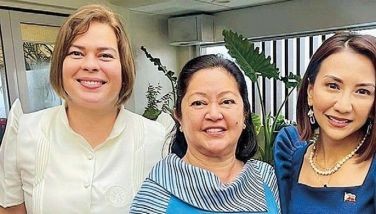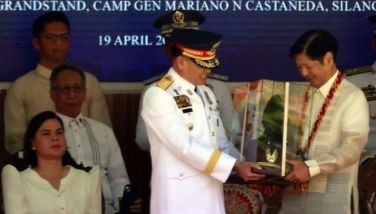Palace defends lump sums
MANILA, Philippines - Malacañang defended yesterday the P501-billion lump sum appropriations in the proposed national budget for 2015, saying these were all adequately explained and broken down as programmed and unprogrammed funds.
The lump sums are also not for individual officials, like the pork barrel that was allocated to each senator and congressman. The President, however, has lump sumps for discretionary spending under his office, such as those for quick response to calamities.
“Based on established management practice, it is customary that a certain portion of the annual budget is set aside for contingency expenditures that are essentially variable and not amenable to precise determination at the time of budget preparation. The national government, perhaps the largest corporation in the Philippines, follows such best practice in establishing the special purpose funds (SPF) totaling P501 billion. Out of this amount, P378 billion are programmed appropriations, while the
P123 billion are unprogrammed appropriations,” Presidential
Communications Operations Office Secretary Herminio Coloma Jr. said in a press briefing.
Programmed appropriations are those with assured funding. Unprogrammed ones can get funds only if there are additional sources of revenue or excess over projected earnings, new loans or new loan proceeds.
The P378 billion in programmed appropriations are the following:
• Calamity Funds – P14 billion;
• Contingency Funds – P2 billion;
• International Commitment Fund (used to pay obligations to the United Nations and other international organizations) – P7.4 billion;
• Pension and Gratuity Funds – P140.6 billion;
• Miscellaneous Personnel and Benefit Fund (for vacant positions, performance-based bonuses and other incentives) – P118 billion;
• E-Government – P1 billion;
• Rehabilitation and Reconstruction – P1 billion;
• Budgetary Support to Government-Owned and Controlled
Corporations (GOCCs) such as PhilHealth and Napocor – P62.7 billion;
• Allocation for Local Government Units – P33 billion.
Coloma said the unprogrammed appropriations include the following:
• Budgetary support to GOCCs – P5 billion;
• Armed Forces of the Philippines modernization – P10 billion;
• Equity buyout of the Metro Rail Transit Corp. – P53.9 billion.
The P10-billion allocation for the AFP Modernization Fund was under unprogrammed appropriations as Special Purpose Fund (SPF) because the Department of National Defense already has an allocation of P5 billion, Coloma explained.
“This is to fulfill the government’s commitment of allocating P15 billion a year at the minimum for the AFP modernization program. But since only P5 billion can be covered by available funds, the P10 billion was placed in the unprogrammed portion of the Special Purpose Funds,” he said.
He stressed that there is a specific appropriation for a specific purpose.
On the two allocations for GOCCs, he explained that the unprogrammed P5 billion could be spent only if there are additional revenues.
Those who want to scrutinize the disbursements of the lump sumps could look at the GAA for this year, Coloma said.
“You will notice that there are very specific notes and provisions on how these appropriations may be drawn or the criteria for drawing upon these appropriations,” he said.
He also pointed out that only 19 percent involved the SPF while 81 percent included line item appropriations for programs, activities and projects.
These are further classified into three expense classes: personnel services for employee salaries and benefits, miscellaneous and other operating expenses and capital expenditures.
“Availment of Special Purpose Funds also involves close adherence to financial control and accountability measures. This must be fully justified by the concerned head of department or agency and may involve vetting by the appropriate Cabinet cluster before being recommended for approval by the President. Actual disbursement is subject to regular auditing rules and regulations,” Coloma said.
Inclusive growth
To promote inclusive development, Coloma said the biggest portion of the budget was allotted to social services at P967.9 billion or 37.2 percent.
The budget also focuses on delivering high impact projects in 44 provinces with high poverty and unemployment, high poverty requiring social safety nets and those which are vulnerable to natural calamities.
“This budget also enhances government’s accountability for the results of public spending. According to the President, and I quote, ‘We continue to implement the basic management principle that each peso that the government spends must be tightly linked to measurable results’,” Coloma said.
“In the 2014 budget, the performance targets were pegged against the outputs or tangible goods and services that the agencies must deliver. The proposed budget for 2015 now includes indicators for outcomes,” he added.
He explained that the proposed budget does not only show how many households or families, for example, will benefit from the conditional cash transfer, but also how many of the beneficiaries will be lifted from the level of survival to a level of subsistence and eventually to self-sufficiency.
DAP lump sums carried over
At least two lump sums in the 2014 national budget, which were among the sources of funds for the DAP, are carried in the proposed 2015 outlay.
These are the Miscellaneous Personnel Benefits Fund (MPBF) and the Pension and Gratuity Fund (PGF).
The MPBF will double to P118.1 billion in 2015 from P53.5 billion this year, while the pension fund will increase by P20 billion to P140.6 billion from this year’s P120.5 billion.
Budget Secretary Florencio Abad admitted that the MBPF and pension fund in this year’s budget were among the funding sources for DAP.
He said Malacañang created the MPBF as a source of money for new and unfilled positions in the bureaucracy because of the practice of agencies to not fill those jobs and to declare the unused money as savings and as a discretionary fund.
“We wanted to put a stop to that practice, so we separated those funds and put them in the MPBF. They can access the money by sending a request to us the moment they want to hire new employees or fill vacant positions. If they do not recruit personnel for new or unfilled positions or if they do so months after the start of the fiscal year, then savings are realized,” he said.
He added that these were the savings that went into DAP.
“We did not take money from existing employees. The MPBF is not the appropriation for the salaries for permanent and contractual employees. We release that 100 percent to the agencies at the start of the year,” he stressed.
Responding to questions, Abad said he did not have the figures on how much of the two appropriations had actually been used for hiring personnel and paying retirement benefits, and how much had been diverted to DAP.
“But we will provide you with those details – all the funding sources for DAP. In fact, we will post them in our website. We are still collating them,” he said.
As for the pension fund, the money for retiring employees was separated also because of the practice of agencies of declaring it as savings and using it as a discretionary fund, Abad said.
“We ask agencies ahead of the budget year to submit a list of retiring personnel to us so that we can set aside the necessary funds. If the personnel postpone their retirement, that is when savings are generated. But if they go ahead with their retirement, we provide the funds from the PGF,” he said.
Government employees have claimed that the MPBF and pension fund savings that Abad said were made part of the DAP fund pool was money taken from them.
Bayan Muna Rep. Neri Colmenares criticized the lump sums in Aquino’s proposed budget.
“With the lump sums in the budget and President Aquino’s command to Congress to change the definition of savings, he wants to legalize the unconstitutional DAP,” he said. – With Jess Diaz
- Latest
- Trending



























